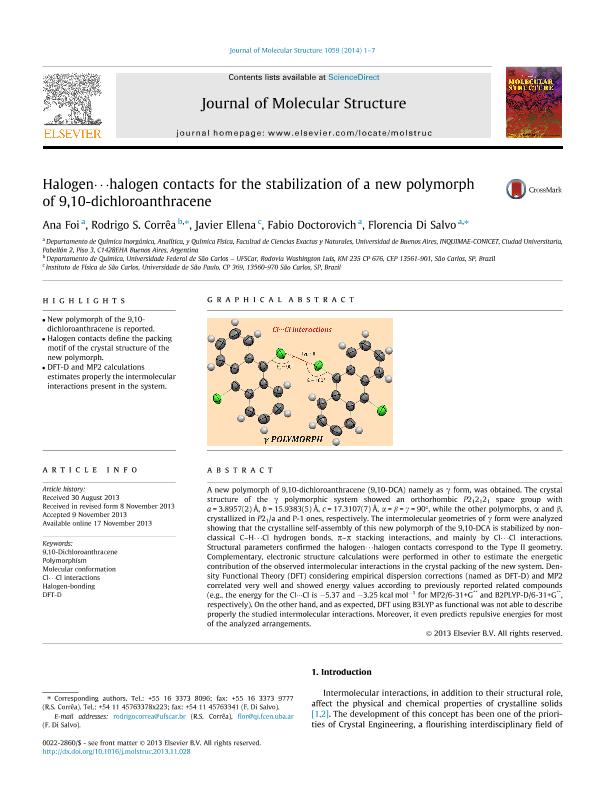Artículo
Halogen⋯halogen contacts for the stabilization of a new polymorph of 9,10-dichloroanthracene
Fecha de publicación:
02/2014
Editorial:
Elsevier Science
Revista:
Journal of Molecular Structure
ISSN:
0022-2860
Idioma:
Inglés
Tipo de recurso:
Artículo publicado
Clasificación temática:
Resumen
A new polymorph of 9,10-dichloroanthracene (9,10-DCA) namely as γ form, was obtained. The crystal structure of the γ polymorphic system showed an orthorhombic P212121 space group with a = 3.8957(2) Å, b = 15.9383(5) Å, c = 17.3107(7) Å, α = β = γ = 90°, while the other polymorphs, α and β, crystallized in P21/a and P-1 ones, respectively. The intermolecular geometries of γ form were analyzed showing that the crystalline self-assembly of this new polymorph of the 9,10-DCA is stabilized by non-classical C–H⋯Cl hydrogen bonds, π–π stacking interactions, and mainly by Cl⋯Cl interactions. Structural parameters confirmed the halogen⋯halogen contacts correspond to the Type II geometry. Complementary, electronic structure calculations were performed in other to estimate the energetic contribution of the observed intermolecular interactions in the crystal packing of the new system. Density Functional Theory (DFT) considering empirical dispersion corrections (named as DFT-D) and MP2 correlated very well and showed energy values according to previously reported related compounds (e.g., the energy for the Cl···Cl is −5.37 and −3.25 kcal mol−1 for MP2/6-31+G** and B2PLYP-D/6-31+G**, respectively). On the other hand, and as expected, DFT using B3LYP as functional was not able to describe properly the studied intermolecular interactions. Moreover, it even predicts repulsive energies for most of the analyzed arrangements.
Palabras clave:
Dichloroanthracene
,
Polymorphism
,
Molecular Conformation
Archivos asociados
Licencia
Identificadores
Colecciones
Articulos(INQUIMAE)
Articulos de INST.D/QUIM FIS D/L MATERIALES MEDIOAMB Y ENERGIA
Articulos de INST.D/QUIM FIS D/L MATERIALES MEDIOAMB Y ENERGIA
Citación
Foi, Maria Ana; Correa, Rodrigo S. ; Ellena, Javier ; Doctorovich, Fabio; Di Salvo, Florencia; Halogen⋯halogen contacts for the stabilization of a new polymorph of 9,10-dichloroanthracene; Elsevier Science; Journal of Molecular Structure; 1059; 2-2014; 1-7
Compartir
Altmétricas




